
Pinnacles visitors drawn to rock formations
PAICINES, Calif. – When you think of Northern California, some of the first images that come to mind are San Francisco’s Golden Gate Bridge, Napa Valley, Silicon Valley’s sea of tech companies or even San Jose’s booming population. Though the area has a mountainous terrain, buildings have been built on top of these peaks and valleys transforming the mountains into a developed tourist destination.
In 1908, President Theodore Roosevelt established Pinnacles as a national monument in order to protect and preserve the unique and striking rock formations the area is named after.
| A visitor walks along the trails of Pinnacles National Park in Paicines, Calif. (Photos by Jordan Coyne). | 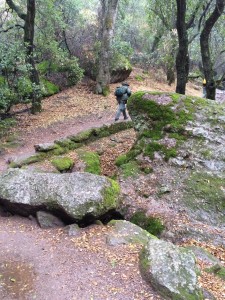 |
And in 2013, the national monument gained national park status, becoming only the 59th national park in the nation. The following year, the park hosted 196,635 visitors from the surrounding areas of San Francisco (two hours north), Los Angeles (4.5 hours south) and the rest of the world.
“Since the beginning of the national parks systems, even as decades have changed, but despite all that, visitors have largely been white, upper-middle class family units … and that is changing really quickly to reflect our really diverse citizenry that we have,” said P.T. Lathrop, the lead for interpretation and education at Pinnacles National Park.
“The visitors here at Pinnacles are in the mature stages of that shift. Our visitors are Latino, Asian, East Indian, German and they are largely not family units, but groups of millennial professionals, all the tech kids, from the Bay area.”
In response to this shift in demographics, Lathrop and his team have recently begun to develop SPACE programs such as the contemplation chair.
Weather permitting, a staff member will walk somewhere within Pinnacles’ boundaries and leave a journal attached to a backpack that is full of writing utensils.
Lathrop explained the point of this program is to allow visitors to share their experiences with others and to also reflect on their explorations.
Rachel Johnson, a 23-year-old who works for the Silicon Valley Ballet Company, said she loves the idea of being able to write in the middle of her hike.
“It would be so neat to sit down overlooking this majestic scene, and just write whatever comes to mind. Especially since there’s no cell service,” she said. Unfortunately Johnson visited on a rainy day, so the contemplation chair was not in use.
| Light peaks through a gap in the ceiling of the Bear Gulch Cave at Pinnacles National Park. | 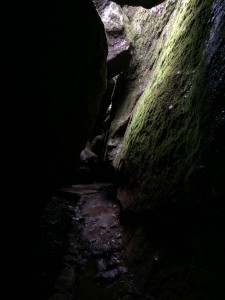 |
Johnson added that she also appreciated the stark difference between Pinnacles and Sunnyvale, her hometown and the new home of the Apple campus.
“One was made by volcanos, and one was made by man. You tell me which sounds cooler,” she quipped.
It is believed the Pinnacles were first created almost 23 million years ago during the Neenach Volcano. The volcano was then split by the San Andreas Fault, while the Pacific Tectonic Plate crept north, carrying the Pinnacles.
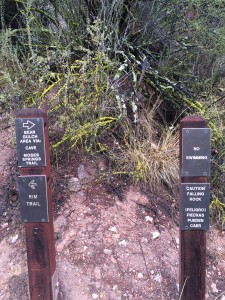 |
Pinnacles National Park trails are marked with easy-to-follow signs. |
The talus caves were created when giant boulders fell and wedged themselves between other rocks, thus creating the caves’ ceilings. The structures that stand in the park today are the result of millions of years of warping from water and wind.
Located in the southern portion of the Gabilan Mountains, enclosed within the park is 30 miles of hiking trails, three creeks, and a reservoir nestled between two mountain peaks.
The diverse habitats throughout the park are home to more than 1,200 species of animals and insects and 674 species of plants, according to the park’s website. Among this wide array of wildlife, are three endangered species – the California red-legged frog, the California tiger salamander, and the California condor.
| Stairs lead from the exit of the Bear Gulch Cave up to the Bear Gulch Reservoir at Pinnacles National Park. | 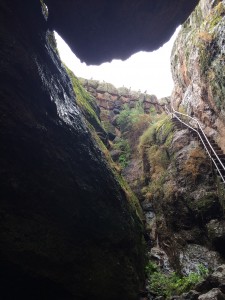 |
When initially established, Pinnacles encompassed about 2,000 acres. Since then, the boundaries have been expanded nine times, most recently in 2011, to increase the area to more than 10 times its original size.
“From a resource management perspective, wildlife need a large area and to be honest, Pinnacles and its current size 26,000 acres is really, dramatically, severely, I will use whatever adverb I can, insufficient to support its wildlife,” Lathrop said. “It is not big enough to support that wildlife that it has. The reason why the ecosystems are functioning and healthy is because the surrounding areas are working range land; so, more or less, natural and undeveloped land.”
This land has allowed Pinnacles to partake the California Condor Recovery Program (CCRP) as a release and management site.
The park currently manages 32 free-flying condors who travel more than 30 miles between Pinnacles and Big Sur, another partner of the CCRP. Funding for this program comes from the park’s bookstore, which is operated by the Western National Parks Association (WNPA), said Linda Regan, the bookstore manager.
“Typically the parks themselves will approach WNPA and ask if they’d be interested in opening a bookstore, and of course they’ll say yes,” she said. “They’re a big company so they can get products into stores at a better wholesale price.”
The WNPA currently runs bookstores at 67 national parks and other NPS sites. The funds from each bookstores are used at the discretion of each park’s superintendent. At Pinnacles, Park Superintendent Karen Beppler-Dorn has requested that funding be used to develop interpretation and education programs.
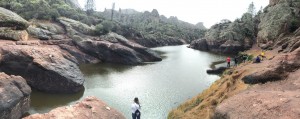 |
| The Bear Gulch Reservoir is nestled between mountain peaks at Pinnacles. |
Mike Carr, a father of three Boy Scouts from Cupertino, Calif., says these types of programs keep his sons interested in their trip and off of their phones.
“The boys were so entranced by the condors in their natural habitat,” he said. “It’s not a bird we’ve seen that often in all of our trips to national parks, and there are so few in the park, so the boys were on high alert the entire time trying to spot them.”
If You Go
- WHAT: Pinnacles National Park
- WHERE: 5000 Hwy. 146, Paicines, Calif., 95043
- CONTACT: 831-389-4486
- For more information, visit http://www.nps.gov/pinn.
Information and Visitor Centers
- Pinnacles Visitor Center (East Side): 33 miles south of Hollister, Calif., via Hwy 25. in Pinnacles Campground on Hwy. 146 east.
- Bear Gulch Nature Center (East Side): Four miles from East Side Pinnacles Visitor Center
- West Side Visitor Contact Station (West Side): 13 miles east of Soledad, Calif., on Hwy. 146. (Highway 146 does not connect east to west.)

Comments are Closed